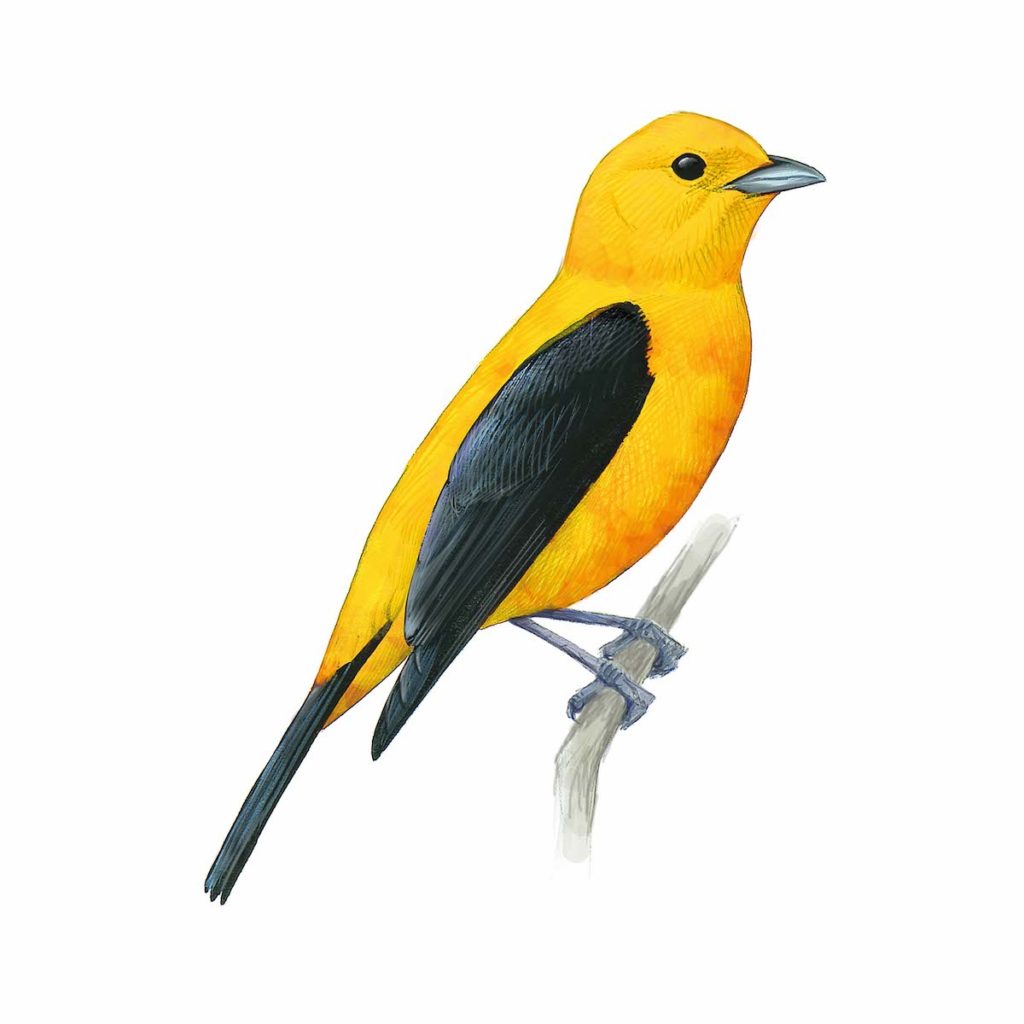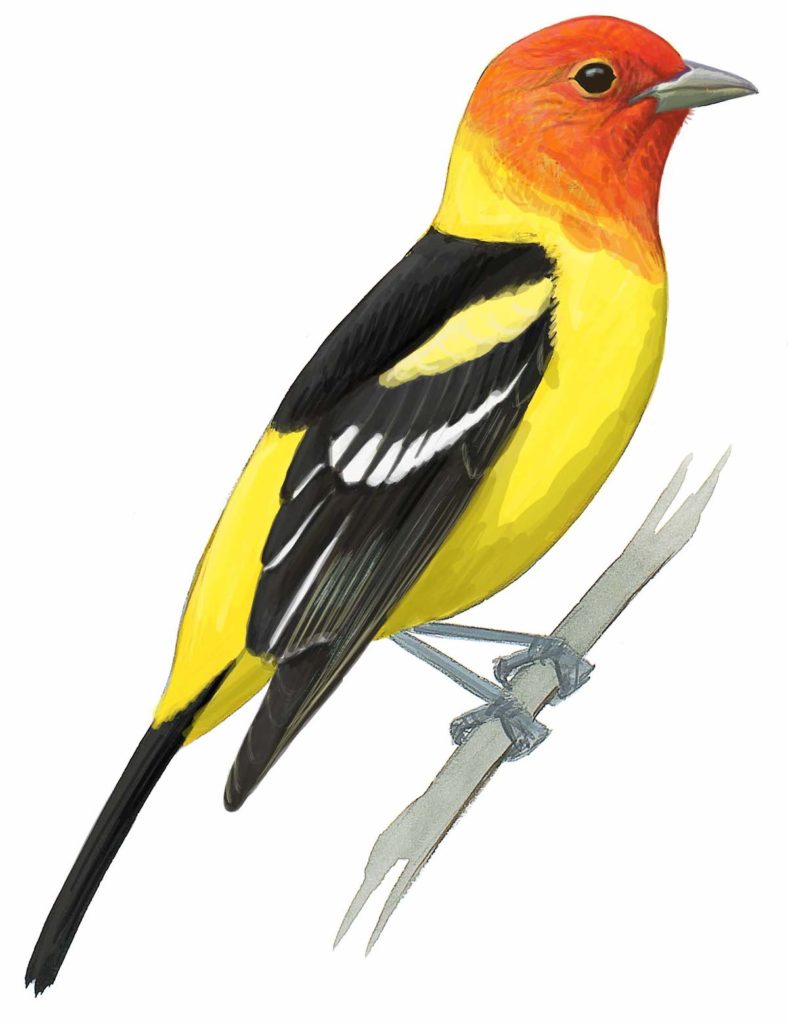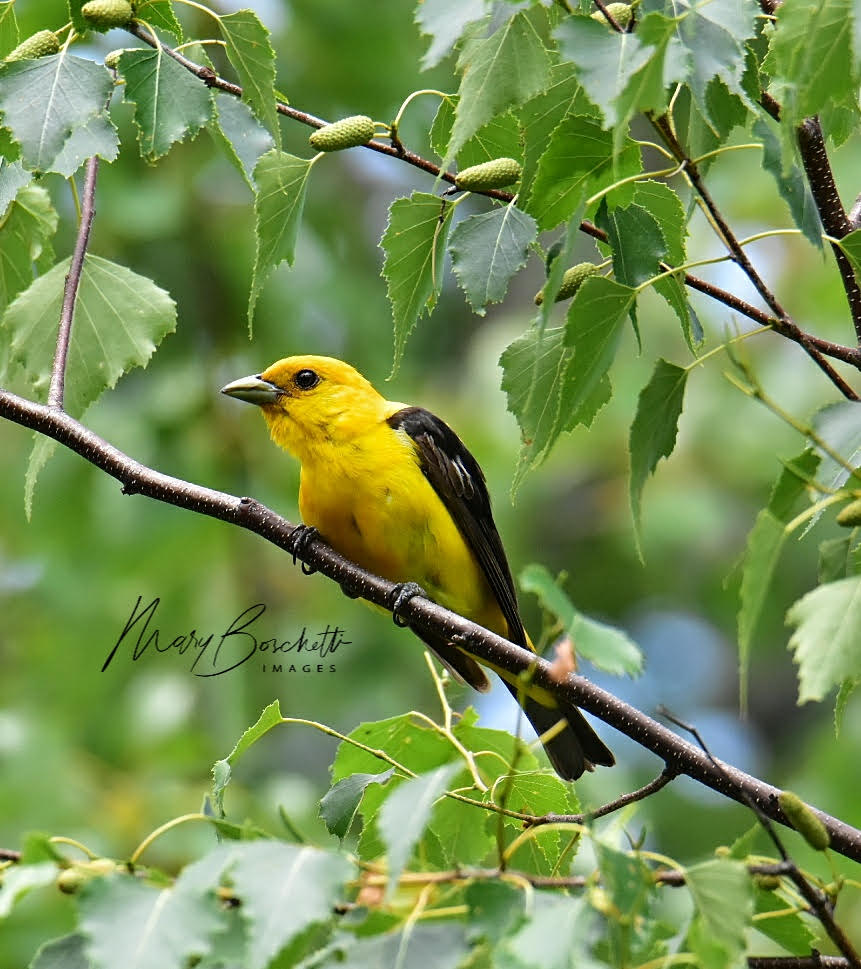One of the great pleasures of birding is that you can run into something new and unexpected anytime, anywhere. This summer (June and July 2020) I’ve been birding around my local neighborhood in Deerfield, MA, and even though I’ve lived here for three years now, every day still brings new discoveries. A recent morning produced a dramatic moment: a Scarlet Tanager unlike any I’ve seen before.

Scarlet Tanagers are fairly common here and I see one or more males almost every day, perching in the treetops and singing. Their glowing red body and black wings are instantly recognizable and always a treat to see.
On June 19th I was looking across a field when a bright yellow-orange bird flew into the trees along the edge. My first thought was “Baltimore Oriole” (an even more frequently seen local nesting species). But when I lifted my binoculars to the bird in the tree it was obviously not a Baltimore Oriole, with a brighter golden-yellow color, mostly yellow head, and black wings. In that split second as my brain spun in an effort to make sense of what I was seeing, the first “match” that came up was male Hooded Oriole! That would be a first record for Massachusetts, but before I could even get excited about that possibility it was ruled out by the all-black wings and all-yellow head. And I realized that I must be looking at an abnormally-colored male Scarlet Tanager.
After only a second or two the bird was chased off by a typical red male Scarlet Tanager. I didn’t see it again for almost three weeks, until it reappeared very briefly in the same place on July 8th. That time I saw it from below and could see that the center of the belly was smudged with orange, closer to the typical Scarlet Tanager color.
I’ve seen many slightly orange-toned male Scarlet Tanagers. These are usually first-summer males (one year old), and look a bit drab, a less intense red with a hint of orange. It seems like they are meant to be red but for whatever reason their pigment is just not as saturated as it should be. This bird was different. It was just as brilliantly colored as a typical male Scarlet Tanager, but yellow instead of red. It seemed committed to yellow. That’s a simplistic observation but there might be some truth in it.
The carotenoid compounds that produce the red and yellow colors of birds are acquired through their diet, and then processed in the body into pigments that are deposited in the growing feathers. If a bird has a shortage of carotenoids, from poor diet or poor health, its feathers won’t develop their full color. This yellow Scarlet Tanager must have plenty of carotenoids (it needs those to produce any bright color, red or yellow), but it might have a mutation to the chemical process so it produces yellow pigment instead of red.
Update 27 Jul 2020:

A reader on Facebook asked if this bird’s yellow color could be the result of hybridization with Western Tanager, which has a yellow body and orange-red face. That’s a good question and worth an explanation. I’m confident that a hybrid can be ruled out by the entirely yellow back and the absence of pale wingbars. Male Western Tanager has a solid black back and prominent white and yellow wingbars (pale tips on the median and greater coverts). A hybrid would be expected to show intermediate features, and this bird does not. It shows the typical Scarlet Tanager pattern with all-black wings and no black on the back.
Update 30 July 2020:
Remarkably, after posting this I heard from Mary Boschetti (Instagram), who had just photographed a nearly identical Scarlet Tanager in Washington, Massachusetts (about 30 miles west of me). The photo shows paler brownish-black wing coverts and secondaries indicating a one-year-old male. (I didn’t see the Deerfield bird well enough to determine the age.) Some might wonder whether these two observations could be the same individual bird. It’s possible but I think the odds of that are vanishingly small. The two locations are about 30 miles apart, and in the forests of this region there must be tens of thousands of Scarlet Tanagers.



Super cool! We had a very orange Scarlet Tanager this spring, along with a really really scarlet one. At one point, they perched together for a while and it was fabulous to see the two together and really compare the colors. Thanks for this story and gorgeous illustration.
So interesting! Thank you so much for sharing your siding an interesting science that goes with it. Take care.
I live in Western Massachusetts and spotted and photographed one yesterday! Sibley Guides, please contact me at email address provided, I would love to share it with you! He was gorgeous!
Mary Boschetti
I also have a picture (from different angles) and would like to see if this is something like what you were describing. It stopped me dead in my tracks and I was transfixed until it flew away. If you send me an email to the provided address I would be very happy to share, as well as receive confirmation. Thank you!
Thanks for the information! I saw one a week or to ago, it is one of the most fascinating bird I have seen! I am 11 years old, I have just started birding in the past two years. My two favorite bird moments are touching a pileated woodpecker on our suet feeder, secondly spotting a harris’s sparrow on the global big day bird count!
Hello! I found one in NYC on October 8th, 2020. Sadly, it struck a building down the street from Central Park and didin’t survive the crash. Happy to share pictures if they’re useful. Definitely a puzzle to figure out!
I was blessed to observe one on September 25th at Governor Dodge State Park in Wisconsin. Absolutely mesmerizing! I too have photographs, not of great quality, but good enough to confirm the observation. I am happy to share with anyone who is interested and I would like to see any photos that anyone else would have. My email is michaelherriot1@gmail.com.
I believe this is what I saw this afternoon while out on a walk. I tried to get a photo (it was an adult feeding a noisy baby) but they flew away. At first I thought “Baltimore Oriole!” Then I realized the adult had been bright yellow and not orange at all. When I got home, I went through the exact same id process you did. Baltimore Oriole? No. Could it be a Hooded Oriole (way out of its range). Probably not. Looked a lot like a Scarlet Tanager, but it was bright yellow instead of bright red. Possibly!? I live in Bloomington, Indiana.
I have seen this bird in the Smoky Mountains here in Western NC. Could not get a picture but will try – as it seems to be hanging around.
How exciting is this!!! I think I may even have experienced the same train of thought as you. I asked my husband to come out and look. As usual, it’s a goldfinch. I pointed out size, no pale bars on the wings, and the head being almost entirely yellow. There is a small black area just above and between the bird’s eyes. This bird comes to one of my bird feeders every single day. For over a week. I cannot detect any mate in the area. I have been able to identify all of the other bird species and none are similar shape or beak. I have been trying to get a decent picture. I have gotten both sides and front and back. Can’t get a pic of the belly, because the camera is inside and on a tripod. Maybe if I can figure out how to photo it, I will. However, using my binoculars, I identified the orangey-dirty yellow smear on its belly. I am so excited. Been bird watching since I was a young child, and I am 69 now.
Pingback: What Bird Is Red And Orange? – Ploverbirds.com
I saw a post from someone who took a photo of 2 scarlet tanagers (a male and a female) who had been chasing eachother and sadly smacked into her window, neither of them surviving. She took a photo of them and posted it and a US Wildlife Official wrote a poem about them. I was confused when I saw the photo because one of the birds is clearly a typical red scarlet tanager…red with black wings and the other is a bright yellow with black wings. Perhaps this is a common mutation in color? Here I’d the article from 2017: https://www.audubon.org/news/an-ode-two-tanagers
Update, I just researched because I was so curious about this. Apparently all female scarlet tanagers are yellow! Only the males are red. See article: https://www.birdsandblooms.com/birding/bird-species/tanagers-and-blackbirds/yellow-tanager/
Springfield TN. I saw a scarlet tanager today that was red from the top to half way down the breast. Then yellow, lower breast to the tail. Male. Thee most brilliant site. Watched him with binoculars for five minutes from thirty feet on a persimmon tree branch.
I photographed an orange variant of a Scarlet Tanager on June 1st and several times since then with the last on June 13th as of this post in Heber Springs, Arkansas. This is the second time that I have seen one, with the other being on Mount Magazine, Arkansas several years ago. I do have photos, but don’t see anywhere to provide the photo.
Kenny Nations
Northern Richland Co. Wisconsin — Very interesting… I had a good view of one in my backyard a couple years ago. Very obvious male scarlet tanager color pattern with bright yellow replacing red. Three days ago, I photographed a wood duck with a strange combination of male and female characteristics. In checking literature, I discovered that she was an old female that took on male characteristics because of her lowered ability to produce estrogen. I’m wondering if that ever happens in scarlet tanagers and if so, what that female would look like.
Does a young, male tanager change from a lime green to bright yellow then to red?
I have a tanager that was green yesterday, but is more yellow today. What will happen next?
Sue
On 9/24/23 I saw the remarkable yellow male Scarlett Tanager for the first time. He was feasting on my Beautyberry shrub. I am in Chapel Hill NC, in the Piedmont area. The following day Summer Tanagers also visited my feeders.
I’m surprised so many of you are unaware that only the male Summer Tanagers are red with black wings. The females are yellow (to orange) with black wings. I love them, because the eat wasps. I frequently see them picking them off the hummingbird feeders. They are quite large birds, but the hummingbirds are not afraid.
I was birding two days ago at Ft. Ancient Archeological Site and Nature Preserve in southwestern Ohio and heard a loud Scarlet Tanager nearby. I used the Sibley app on my phone to bring him closer so I could get some photos. I was surprised to see this beautiful yellow, orange, and black “Scarlet” Tanager fly in and pose for an extended photo shoot. Tonight, I did a web search on “yellow-orange scarlet tanager” and found this blog. Here is a link to some of my photos of the bird:
[link hidden]
This morning (July 5, 2024) I saw a male Scarlet Tanager eating mulberries from the trees in our back yard by a wooded area in West Des Moines, Iowa. This one was mostly scarlet with black wings, but with a bright yellow back half of its belly, sort of a big vent area. I also saw a standard color male and female Scarlet Tanager somewhat later in the same location. I wonder if this is a first summer male transitioning to all scarlet and black. Any comments?
Today (September 26, 2024) in Richmond Virginia I saw a stunning, bold yellow–not olive, almost lime green–bird with black wings. Tanager sized and bill. My birding partner told me that it was a first year male scarlet tanager. My field guide says adult male molts to “yellow-green” in winter.